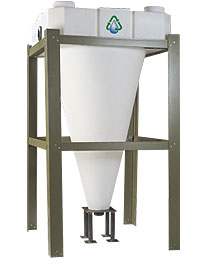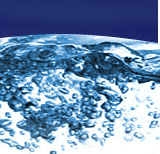
QuikSand Delta Advanced Fluidized Bed
Filter

 In
development for more than 15 years, this is the most advanced fluidized
bed filter available on the market today. It features a tapered
column design (3 U.S. Patents granted, 2 pending) and a media by-pass
line that ensures years of trouble-free service. In
development for more than 15 years, this is the most advanced fluidized
bed filter available on the market today. It features a tapered
column design (3 U.S. Patents granted, 2 pending) and a media by-pass
line that ensures years of trouble-free service.
The new column design greatly reduces the chance of an accidental
media “wash out.” As the chamber widens at the top,
the greater cross-section of the cylinder slows the water’s
velocity and contains the media. The filter can also be plumbed
(if desired) with a media by-pass line that allows the operator
to feed water into the filter media both internally and externally,
virtually eliminating the chance of accidentally clogging the center
supply tube.
About Fluidized Bed Filters

Fluidized bed filters are rapidly becoming the primary source of
biological filtration in many modern aquaculture systems, replacing
the less efficient "trickle" filters now in service. While
trickle filters and fluidized beds both rely upon the same species
of bacteria for ammonia and nitrite removal, it's how the two filters
operate that sets them apart. It's very helpful to remember that
in biological filtration, it's actually the bacteria that do the
work; the filter itself only provides a suitable "home"
for the bacteria to colonize.
Trickle filters can best be described as open containers filled
with various forms of solid media. As water enters the top of the
filter, it drains down through this media in a random, cascading
fashion. Since the media is stationary, it relies upon the changing
water currents to keep the bacterial surface area moist.
Fluidized bed filters, on the other hand, are flooded cylinders
or tanks, partially filled with a granular media, such as white
quartz. Water upflows through this media bed, causing it to expand
and fluidize. The large number of bacteria that colonize this expanded
media serve to remove the nutrients that are present in the flowing
water. What results is a highly efficient filter bed that is no
longer solidly packed, but is in dynamic motion. It is this combination
that is the key to our QuikSand Filter's success.
While trickle filters may have relatively large amounts of surface
area (up to 200 square feet per cubic foot of media), it is virtually
impossible for bacteria to colonize all of it. This is because water
will take the path of least resistance as it moves down through
the media, often leaving dry areas and low flow, anaerobic pockets.
Another serious problem with these filters is called "bio-fouling."
This occurs as particles of organic material lodge within the filter
bed. Once clogged, you have no choice but to tear the system down
and clean it. This is not a pleasant job; but if left unattended,
your water quality will rapidly degrade.
Fluidized bed filters, by design, do away with the trickle filter's
shortcomings. The most obvious benefit is that all of the filter's
large surface area is available for bacterial growth. With more
than 6,200 square feet of surface area per cubic foot of media,
you can quickly understand why fluidized bed filters don't need
to be nearly as large as comparable trickle filters. Since the water
is evenly distributed as it flows through the cylinder, there are
also no anaerobic pockets of bacteria developing. The water that
reaches the media is oxygen rich and very conducive to rapid bacterial
growth. Also, these filters are almost impossible to clog due to
the constant motion of the media. The filter bed is a mildly abrasive
environment that is constantly cleaning and renewing itself as it
moves quietly around inside the cylinder.
|



